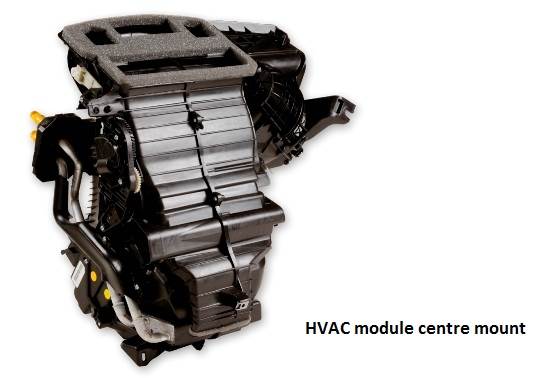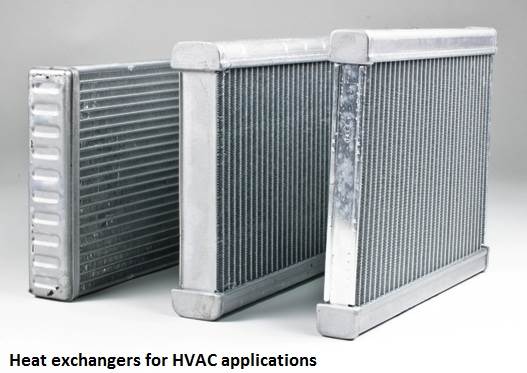'We plan to leverage our presence in all the key auto hubs in India for future growth.'
Murali Vaidyanathan, MD of Chennai-based Hanon Systems India, on the growing demand for powertrain cooling and HVAC products in India, opportunity from upcoming BSVI norms and the company's future growth.
Murali Vaidyanathan, managing director of the Chennai-based Hanon Systems India, speaks to Kiran Bajad on the growing demand for powertrain cooling and HVAC products in India, the opportunity that upcoming BS VI norms present, and how the company can leverage its presence in all of India's automotive hubs to drive future growth.
Last year, a change of management saw Halla Visteon Climate Control rename itself as Hanon Systems India. How do you see the India business plan and the road ahead?
Hanon Systems India has a sound business plan for the next five years and we expect the Indian market to grow by 7-7.5 percent each year. With higher growth, we are going to comfortably beat that growth rate of the industry.
Today, we are present in all the key automotive hubs in India including Chennai, Pune, have one joint venture plant with Maruti Suzuki in NCR and our latest plant in Gujarat which opened last year.
Being present in all the hubs, we will leverage this further for our growth. In India, different OEMs have diverse plans, for example, some are looking at significant export and some are expanding domestic capacities and both these scenario are major leverage point of us.
Hanon Systems is committed to growth in India. Globally, our emerging market footprint is very strong with nearly 40 entities and three-quarters of our geographic presence is in emerging markets. We have a strong presence in China, India, ASEAN and a growing presence in South America and Mexico besides the conventional markets of Europe and US. This should fuel Hanon Systems’ growth considerably in these markets.
Given that the Indian market is slated to grow by 7-8 percent, what growth will Hanon Systems post?
We are confident we will outgrow the market but predicting the number is difficult, largely due to various factors. For example, the diesel-petrol mix and our presence in those fuels. We have current business in all the four locations with a strong future order book. Besides this, we are also talking to OEMs for new business. All these will make us outgrow the market comfortably.
At present, you are supplying powertrain cooling and HVAC products to all the major OEMs in India. Do you think the existing volumes or new business will fuel growth in the near term?
Yes, globally, with many more models to come, the expected growth is about three percent. But the thermal portion of the industry will grow by a little over five percent.
With the upcoming regulation and technological changes, we do see opportunities that will come to us which are more than the normal vehicle growth that would take place. We have a strong customer presence in India and want to leverage it for our growth. The order book is sufficient to fulfill the business plan. We have orders from OEMs which are doing volumes in India and for export and we will continue to cater to both the segments.

Hanon Systems’ exposure in India has largely been in the passenger car segment. Would that remain so or do you see opportunities in other segments?
Our presence has been in passenger cars and utility vehicles. Traditionally, we have been operating in the passenger vehicle market but I am sure, like any other player, we are looking at leveraging the adjacent markets and are currently studying them.
We will explore that market when the right opportunity comes to penetrate it. With the government's focus on infrastructure and investments, I foresee the Indian commercial vehicle market to grow significantly over the next 5-6 years and the market looks quite attractive.
In the HVAC or powertrain cooling products that you supply to the domestic market, are there any India-specific demands or is the market evolving to global trends?
Expectations from the air-conditioning system are always very high and customers definitely differentiate between systems and are willing to recognise that. While buying a car, interior comfort and air-conditioning is one of the biggest factors. I am sure, going forward, it will also include air quality. These are going to be important factors and over a period of time will continuously gain importance. The Indian market will continue to demand higher quality products, like any other developing market.

In emerging markets like India, do you see challenges in Hanon Systems’ product offerings while addressing OEM expectations?
I don’t think we have a technological challenge at this stage. The Indian market is not yet a technology market and there are very few markets out there globally. For example, Europe is a technology market and we have a number of offerings developed for that market.
In electric vehicles, we have a strong product portfolio. Similarly, for emission products we have a strong product range. With new regulations coming in the next 4-5 years, many of these technologies will see higher adoption. In India, the transformation from BS IV to VI will provide us an immense opportunity.
Can you detail your products for EVs and the different set of challenges?
For electric vehicles, we have our own set of products and systems. Since the conventional powertrain is not there, this will help in offering much more flexible solutions within the vehicle and also opportunities in terms of space and comfort.
Today these technologies are expensive but as they get evolve, they will become affordable. At present, quite a few of our EV products are getting installed or in the process of installation globally. Hanon Systems globally has solutions available not just for EVs, but the air-conditioning R1234yf refrigerant is fitted in Europe. We have the capability of meeting CO2 and also have products which we are going into fuel cell vehicles. So for any technology and fuel preference, we have a product. We have products for emission control too. Basically we are into powertrain cooling, HVAC system and exhaust management system with EGR cooler.
Emission products will clearly see a demand uptick as India moves towards BS VI standards by 2020.
Yes, EGR will start to play a bigger role in these emission requirements. There are a set of products which will be an opportunity for emission norms. OEMs are discussing various technology options for them and depending upon the technologies they use, they will choose which of our systems would be more suitable.
Independent of the choices they make, we have all the products that are required and definitely we see an uptake in terms of emission products. At present, we have an EGR cooler (which is very recent) in our Bhiwadi plant and it is growing. But we can also bring other products from our global portfolio as and when the Indian market demands them.

Can you list some of the global trends coming in HVAC systems and powertrain cooling?
I feel demand for automatic AC installation will start growing. Currently, this is available only in premium cars and higher-end segments but will grow rapidly. Around 7-8 years ago, it was only in the C-segment and above cars but today in the B-segment, FATC (Full Automatic Temperature Control) is offered in at least one variant. Besides this, the emphasis on air quality will go up. Lastly, powertrains are getting more and more efficient and there is more demand for heat exchangers that cater to those powertrains.
What is Hanon Systems’ approach to product development in India?
This actually depends on what the customer requirements are. Wherever the customer’s engineering gravity, we will cater to them there. For example, if there is global product development at one engineering centre, we will cater to them at that location. If they want to do something specific to the India market, then we will do it here.
We offer flexibility depending upon customer preference. For example, the system developed for the Renault Kwid (HVAC, radiator, condensor and AC lines) was between our India and Korea teams. It was a wonderful collaboration between our local engineers and the Korea team and both worked in good synchronisation.
Working on the Kwid project was a brilliant experience in terms of engineering with a lot of experimentation, flexibility in choices and we have learned a lot from this project. In this project, the most important part was the technology. Our expertise comes into play because, despite being competitive, it offers passenger comfort which is expected from a high-end car.
In terms of your footprint in India, you are present across the auto clusters. What is the current capacity utilisation at all your plants and are you looking for fresh investment in India?
Over the last decade, we have continuously invested in developing capacity and will continue to do so. In terms of physical presence, we are at each location including Chennai, Pune, NCR and Gujarat, covering all the hubs and have enough to grow at each location.
Capacities depend on locations and products. While in some products we have full capacity and would look for expansion, in some products we have extra capacity. A new plant has come up in Sanand but we would leverage it going forward. We never shy away from investing; what is important for us is growth – the investment will follow.

What are the localisation levels for HVAC and powertrain cooling products in India and is there import of products?
There is some import as there are not enough suppliers in India. However, over the years, we have worked very hard on localisation.
At present, we have reached a significant level of localisation. I think any player who does not have focus on localisation will not able to compete in the India market. Ten years ago, our localisation levels were not very high but today we have reached a very high level and continue to work with our suppliers for further localisation with special focus.
Suppliers are our partners and we have a dedicated team working with them. We have a dedicated supply base and we work with them very closely.
How important is the Indian market for Hanon Systems in the Asia Pacific region?
India always has been a very important and priority market for us. Hanon Systems is committed to developing deeper customer relationships and we will do the necessary investment. In terms of industry growth, in the next five years, India will be among the highest in the world among the large markets.
What are your export levels from India?
We do export out of India but the operation is relatively small and should grow in the future. As an organisation, we don’t have a special target for export but would like to grow. We also want to see our exports growing, particularly to emerging markets, and adding value to Hanon Systems. However, ours is not an export-driven business market because we are already present across regions. Importantly, OEMs prefer us to manufacture at the location where they are present
RELATED ARTICLES
Setrans Mobility Booster Charging top-up 25% EV range in 15 minutes
Two enterprising tech-savvy entrepreneurs Rana Roshan Singh and Vivek Ummat of Noida, Uttar Pradesh-based start-up Setra...
'Our products are proudly 100% designed and made in India'
Creatara Mobility, a New Delhi based electric two-wheeler startup, claims to have tackled various challenges in making i...
'EVs have been around for a much smaller time than ICE, so best practices are still evolving'
EV OEMs and start-ups are under pressure to reduce production costs and bring them close to ICE counterparts. Vaibhav Ku...





 By Kiran Bajad
By Kiran Bajad
 12 Aug 2016
12 Aug 2016
 9121 Views
9121 Views









